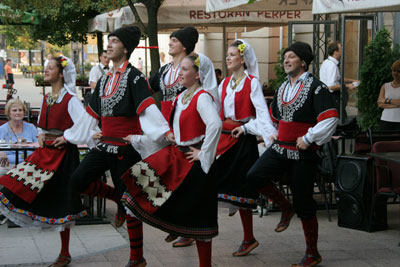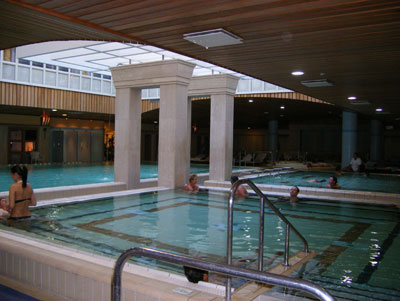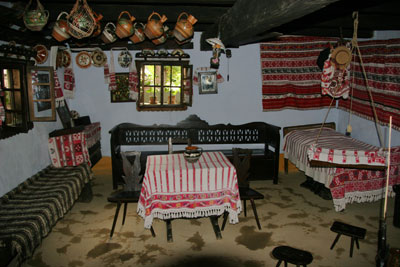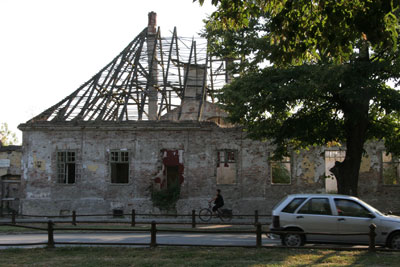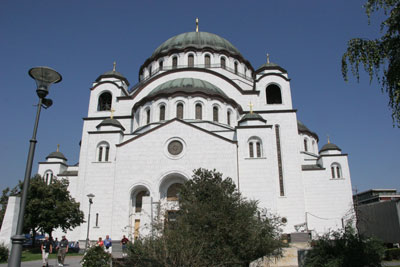The pros and cons of a 5-country whirlwind tour of Eastern Europe
Paula Prindle, Orient, OH
Okay, most seasoned travelers poke fun at whirlwind tours, ourselves included, and swear they’ll never, ever take one — but we did. My husband, David, and I fell for a 13-day, 5-country trip through Eastern Europe in August-September ’08. We were leery, but since it was a river cruise we decided to give it a go.
Choosing a tour
Knowing very little about the five countries to be visited, we figured that a Danube River cruise offering a glimpse into each one would be a good introduction to this part of the world. As it turned out, it was a bit of a hassle to learn basic phrases in five languages and face five different currencies (none of the countries visited are yet on the euro), but it was well worth it.
We were eager to discover the people and lands behind the Iron Curtain before they become too Westernized and hoped to find answers to some of our questions about the area. How did they feel about Americans? Why was there so much recent upheaval? Had the scars of the 1990s healed? What was it like growing up under Communism?
We chose the “Eastern Europe to the Black Sea” cruise-tour with Grand Circle Travel (Boston, MA; 800/248-3737, www.gct.com). We received a postcard from Grand Circle with a last-minute sale price of $1,995 per person plus taxes and fees. We felt that it gave us the best-value basic trip with the freedom to add optional tours along the way.
The tour included two nights in a nice Budapest hotel, seven nights on the Danube aboard the River Adagio and two nights in an even nicer hotel in Bucharest.
Beginning in Budapest
We started in Budapest, the most Westernized of all the places we visited. Most ITN readers probably know and love Budapest, but this was our first visit. The Hungarian capital provided our first “magic moments,” those times you always remember after a trip, after you have forgotten the long layovers, sleepless nights, chronically late tour group members….
As magic moments go, our tranquil picnic lunch in the park on Castle Hill next to the Matthias Church, officially named Church of Our Lady, would be hard to top.
In the leafy shadows of one of the towers of Fisherman’s Bastion, we munched on sandwiches accompanied by ice-cold Coke. We had broken away from our morning tour group to visit the Matthias Church, which doesn’t open to visitors on Sundays until 1 p.m.
A friend had recommended seeing the interior of the church with its “Eastern color scheme meets Western architecture” style, and it was well worth the price (700 forints, or about $4.40, per adult). Although ugly on the outside (there is extensive ongoing renovation work), the 13th-century Church of Our Lady is a gem.
Making memories
We fondly remember wandering around the Royal Palace grounds, gazing down on the funicular and following the drum-beating parade of “Crusaders” and “Turks” heading to a 17th-century confrontation.
Maybe it’s the calories burned or the freedom of not sitting in a tour bus or maybe it’s the jet lag, but, somehow, the magic moments happen more often when we are exploring on foot away from the group.
We have a musical memory from Budapest which happened in St. Michael’s Church on the bustling pedestrian shopping street Váci utca. The organist was practicing, and the swelling sounds filled the cool, quiet nave, renewing our stamina.
But our favorite stamina renewal came at our hotel. The Ramada Plaza Budapest (the former Corinthia Aquincum) was built over a hot mineral spring. In the evening we wrapped ourselves in terry cloth robes and indulged in the complimentary spa access. Three large pools (cold, warm and hot), a hot tub, steam rooms and an exercise room were available for our use. Massages, mud baths, etc., could be had for a fee.
Continuing to Croatia
Croatia was surprisingly full of magic moments — more than any of the other countries — yet we spent fewer than 12 hours there. Armed with our passports, we left the ship in Hungary and bused to the border.
At the crossing we got our first jolt of Croatian friendliness. The Hungarian border guard collecting the passports was all business, but his Croatian counterpart was positively chummy!
Perhaps the key to unlocking Croatian congeniality is slivovitz (plum brandy). Our local guide explained to us that the small bottles of slivovitz are called “timepieces” by the local laborers. When the bottle is empty, it’s time to go home.
The area of Croatia that we visited was far from the prosperous Croatia that most tourists see (Dubrovnik and the Adriatic Coast). We were in Slavonia, a region of Croatia wedged between Hungary, Serbia and Bosnia & Herzegovina.
This area was heavily damaged during what we heard called The Homeland War (1991-95). We passed many roadside signs warning, “Danger — land mines,” and many buildings reflected the carnage that took place there.
We heard stories of families torn apart, with loyalties on both sides due to Serbs and Croats having intermarried for decades. Neighbors turned on neighbors and friendships crumbled. Many locals, like our luncheon hostess, left Slavonia for seven years, returning home only after the fighting ceased.
Local interactions
Grand Circle often includes home-hosted meals or snacks so that travelers can interact more closely with the local people. Our hostess, Snjezˇana Bagaric´, welcomed 10 of us with a wonderful lunch of dumpling soup, meat patties, fried potatoes, slaw, tomato salad, garlic eggplant (super), apple cake, wine, cherry water and, of course, slivovitz, made by her cousin.
She talked about living and working in Germany during the war, how hard life was in Slavonia then, how hard it was to start all over after the war and how lucky she was to have a stonemason for a husband. She told us that the average salary of today’s Croatian is about $600 per month. In fact, she was frank with her answers to all of our questions.
Snjezˇana runs a B&B (sinisa.bagaric@os.t-com.hr) in her lovely home and has two rooms available with facilities en suite. She said that tourism is not yet booming in Slavonia; most of her lodging requests come from bicyclists, hunters and bird-watchers.
The most magic moment of our whole trip happened just before we left Croatia. We met our ship in the horribly destroyed town of Vukovar, the site of much bombing in 1991. Four of us set off to visit Castle Eltz, a former UNESCO World Heritage Site. I say “former” because the castle, built in the early 1700s, is now in ruins.
We were wandering through the rubble, gazing up at the remains of a “Tara style” staircase when we detected the “phoenix rising from the ashes.”
From outside the crumbling walls, we heard the sounds of a chainsaw! A man no longer in his first youth was busily buzzing on two huge tree trunks. A younger woman, his daughter Daria, explained to us in remarkable English that he was making two copies of a dugout canoe (circa 5000 BC) that was once part of the collection at Castle Eltz. One of the reproductions was to grace the reconstructed castle.
As Daria polished her English with us, I tried out my four or five Croatian expressions. Then Daria’s dad took out a large pocket flask of slivovitz (no little timepiece, this one), took a swig and passed it to me! We all ended up tasting the “liquid hand grenade,” grinning as we swallowed.
Serbia
Serbia was a bit sobering after Croatia, but the country is making a comeback. Our Belgrade city guide told us that 10 years ago the average monthly salary was $3. It is now about $1,000.
The currency was devalued 14 years ago and hard times followed. We bought old bills with 10 and 11 zeroes on them.
Our afternoon guide, who tried so hard to show us the country he loves despite its flaws, accompanied us to what was called “a Serbian wedding,” actually a half-day visit to Smederevo, a small town outside Belgrade where local dancers entertained us by mimicking Serbian wedding preparations.
These six young people dressed in heavy wool costumes jumped and cavorted and whistled for over an hour in the extreme heat. They never missed a step or loosened a smile, although the temperature was near 100ºF. They easily won the applause and admiration of appreciative Americans hungry for a taste of the culture.
More glimpses into Serbian culture were to be had at Belgrade’s outdoor markets and at their splendid Ethnographic Museum (entry, 120 dinar, or $2.40). The museum features Serbian ethnic costumes along with complete rooms typical of houses from all over Serbia, many displaying the Turkish influence so prevalent in the Balkans. The museum could use a little A/C.
Q&A
Three graduate students from Belgrade University came on board the River Adiago to talk to us about modern Serbia and answer questions. These three were not defensive about their country and frankly answered all questions put to them, but they did suggest that they thought our media told only one side of the story, just as theirs did.
An eye-opening learning opportunity for us was the discussion of living under Communism, conducted by our program directors. Life behind the Iron Curtain in their native lands of Czechoslovakia, Hungary and Romania was discussed in some detail.
Bulgaria, briefly
Bulgaria was an 8-hour field trip. If there was one country on this cruise where we needed more time, it was Bulgaria. We didn’t even change any currency, since the merchants in the towns we went to, Veliko Târnovo and Arbanassi, accepted dollars at a fine exchange rate.
We spent two hours on the bus each way, leaving us four hours for sightseeing in two towns and an included lunch. Luckily, we took a lot of photos and videos so we can remember what it was like.
In Arbanassi, the beautifully frescoed Orthodox Church of the Archangels Michael and Gabriel contained two rooms inside, one for men and one for women, festooned in colorful frescoes from ceiling to floor, no stone left unadorned.
Neighboring Veliko Târnovo is much older than Arbanassi. It was inhabited as early as 5500 BC and the Romans built its first fortress walls. The town has a picturesque location with panoramic views, is home to Bulgaria’s most prestigious university and is a main stop on the Bucharest-Istanbul train line. It deserves more than a cursory glance.
Be sure to brush up on your Cyrillic alphabet if traveling to this area of the world; it is used in Serbia as well as in Bulgaria. Not only is the Bulgarian written language hard to read, but their body language can be just as difficult. Like their Greek neighbors, Bulgarians shake their heads for “yes” and nod up and down for “no.”
Romania
Our fifth and final country was Romania. Maybe it was because our superb program director, Hunor Nagy, was from Romania or maybe it was because we had some quality free time there, but we thoroughly enjoyed this country. In retrospect, we probably should have opted for the 3-day extension to Transylvania.
Our magic moments in Romania occurred in Bucharest at the Village Museum. We went on our own with another couple and spent 4½ hours wandering through this bucolic lakeside attraction.
Dozens of homesteads, churches, mills and windmills from the 18th, 19th and 20th centuries have been relocated here from all parts of Romania. A day spent in the Village Museum is truly a journey through space and time.
Although we took a taxi both ways, this last day in Eastern Europe was incredibly cheap. The round-trip taxi fare, including tip, was 26 lei ($11). Split four ways, that was a deal.
By showing our driver’s licenses at the museum, we got the senior discount and paid the equivalent of $1.25 each.
Overview
Five countries are a lot to take in and appreciate, even on a long voyage. Because we arrived in Budapest in the evening, we actually had only 10 days (11 nights) in Europe. We felt a little rushed and only skimmed the surface of these five nations, but we did find that we were able to pinpoint places we’d like to investigate further.
Cruising from country to country made transitions much easier, and the Grand Circle crew and staff provided insight as well as comfort on our Eastern European odyssey.
Note: make sure your passport has enough empty visa pages for the five countries you will visit. Officials may stamp pages that already hold entry and exit stamps, but you can’t count on it. The US Passport Office charges no fee for additional pages, but you must send in your passport. I sent mine in late July 2008 and it was back in eight days.


